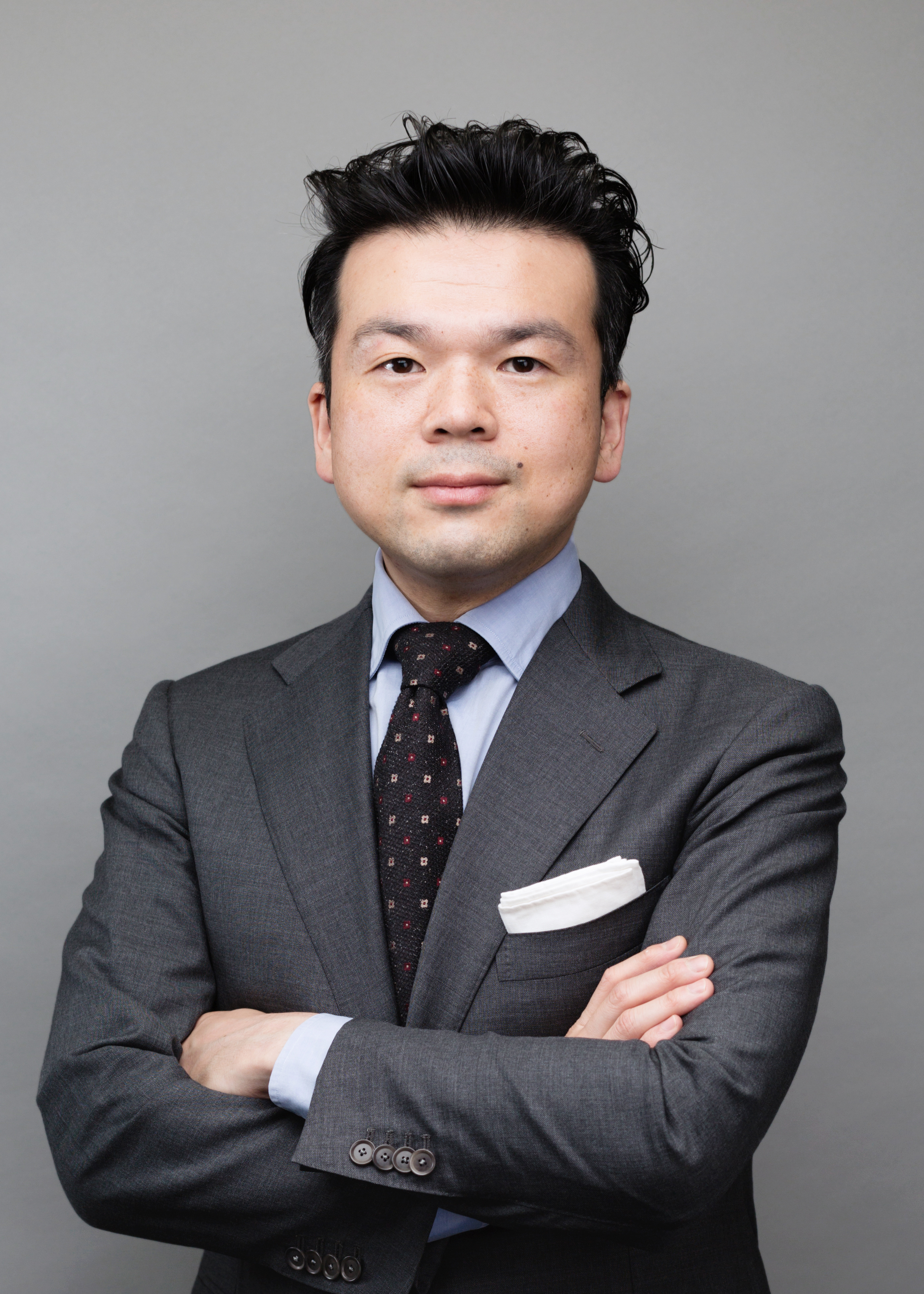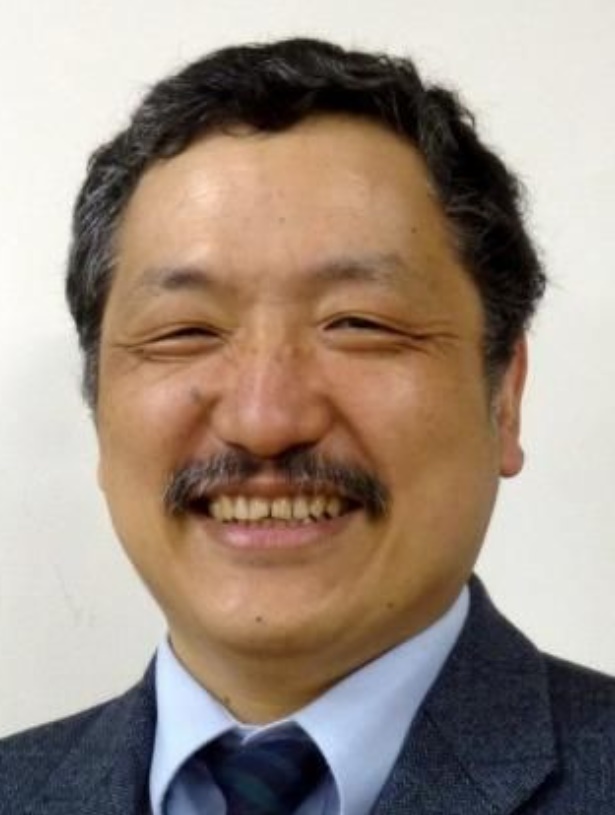Optics Expert Takes on Tenmoku Tea Bowl
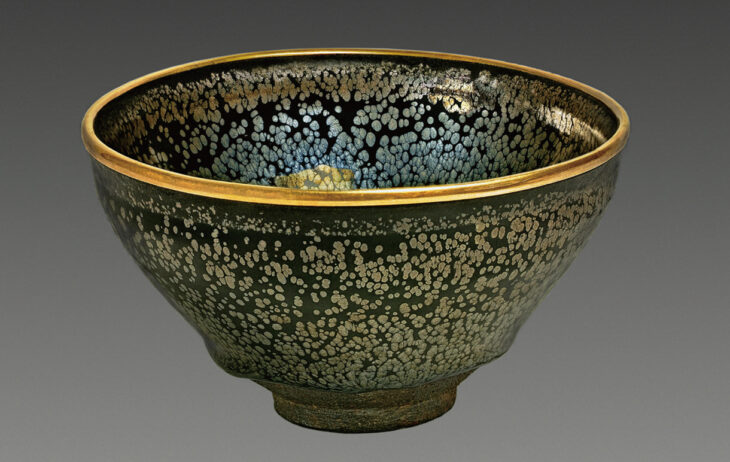
Figure 1: National treasure Yuteki Tenmoku tea bowl
Photo: The Museum of Oriental Ceramics, Osaka (gift of SUMITOMO Group, the ATAKA Collection), photograph by NISHIKAWA Shigeru
A number of tenmoku tea bowls[1] were brought to Japan from China during the Kamakura period (1185–1333) and have been carefully passed down ever since. Among them, the most highly valued are the small number of “Yuteki Tenmoku[2]” and “Yohen Tenmoku[3]” tea bowls, designated as national treasures, which have unique oil spots and luster. This luster has been a great mystery not only to the potters who have tried to reproduce it, but also to researchers. In contrast to the previous theory that the luster is actually thin-film interference on the surface of the tea bowl, RIKEN researcher Ebizuka Noboru has proposed a new theory that the luster of the national treasure Yuteki Tenmoku tea bowl can be reasonably explained by the overlapping of light (multiple interference) caused by two-dimensional sine curve wrinkles.
Discovering the National Treasure Yuteki Tenmoku tea bowl
Whenever a national treasure tenmoku tea bowl is exhibited in a museum, many aficiniados gather, eager for the opportunity to see it. One of the national treasure bowls, the “Yuteki Tenmoku”, is a small tea bowl covered with a generous amount of black glaze containing iron, and the inside and outside of the bowl are covered with blue-purple luster, with a pattern that looks like fine oil drops scattered on the surface of water. Its ethereal appearance is very worth seeing (Figure 1).
During the Song Dynasty in China, many tenmoku tea bowls fired in the Jian kiln (in present-day Fujian Province) were brought to Japan by visiting monks and passed on to feudal lords and other families. The oil spots and luster were not artificially created by scattering heavy metals in spots, but were the result of changes in the kiln caused by firing conditions. The true nature of luster is a “structural color” that is created by the wavelength of light.
Why does the beautiful structural color appear? In the mid-20th century, a renowned ceramics researcher and inorganic chemist proposed that the luster of yohen tenmoku tea bowls was due to “thin-film interference” on the surface of the bowl, and this theory has since been accepted. Thin-film interference is a phenomenon in which light waves reflected from the front and back of a thin film interfere with one another, and can be seen, for example, in the iridescent surface of a soap bubble.
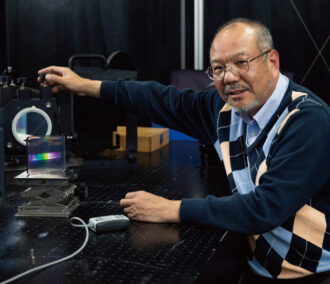
Dr. Ebizuka Noboru
Ebizuka is an optical engineering specialist who has been involved in the development of grisms (a spectroscopic device that is a combination of a prism and a transmission diffraction grating to diffracted light of any desired wavelength in a direct vision direction) for the Subaru Telescope, but he became involved with the yuteki tenmoku tea bowl through an unexpected turn of events. “Photographer Nishikawa Shigeru, known for his excellent images including of national treasure tenmoku tea bowls, was taking photographs with good color balance by lighting his subjects with a planar light source (a flat-illumination light source) equipped with two types of LEDs. The lighting fixture manufacturer asked us to investigate the relationship between color and lighting,” says Ebizuka.
The clue was the wrinkles on the surface
A little over 10 years ago, a researcher proposed a theory for the luster of tenmoku tea bowls that was different from thin-film interference. Ceramics researcher and potter Nagae Sokichi asked materials scientist Fukushima Nobuaki (then at Toyota Central R&D Labs) to use a scanning electron microscope (SEM) to examine a fragment of a Jian Kiln-made “Nogime Tenmoku” tea bowl he had. In this type of tenmoku tea bowl, the glaze flows and creates a pattern that looks like elongated oil spots, and the luster appears there.
SEM images showed periodic wrinkles on the surface of the fragments. The shape was reminiscent of wind patterns in the desert or the surface of the brain (Figure 2 left). It was thought that the wrinkles were caused by the difference in the shrinkage rate of the glaze that occurred during cooling after firing between the glassy layer and the surface polycrystalline layer (The DF-STEM image of figure 2 right). Therefore, a theory was proposed that “the period of the wrinkles is equal to the wavelength of visible light, so the reflected light interferes and creates the iridescence.”[4]
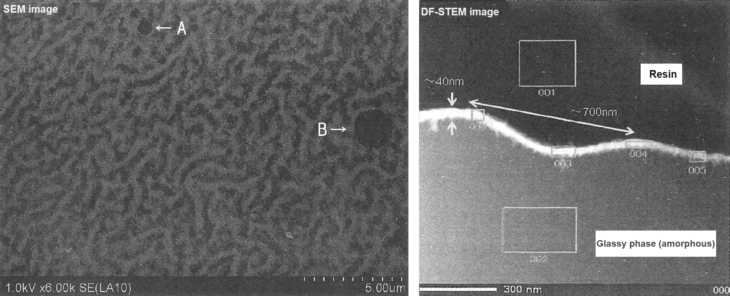
Figure 2: Fragment of the Nogime Tenmoku tea bowl (Left: SEM image of surface, Right: DF-STEM (Dark field scanning transmission electron microscope) image of cross section)
Periodic wrinkles can be seen on the surface in the left panel. White area between resin and glassy phase is polycrystalline layer in the right panel. (Reprinted from the article published in Toyo Toji (oriental ceramics) Vol. 41, NAGAE, Soukichi IX/ FUKUSHIMA, Yoshiaki, “Research on Song Dynasty Jian Ware Tea Bowls”)
Ebizuka learned about this paper on the “wrinkle” while researching tenmoku tea bowls. He then increased the saturation of an image of the Yuteki tenmoku tea bowl taken by Nishikawa and observed a green color surrounding the bright blue of the luster.
“When I saw that, I realized that the ‘wrinkles’ functioned as ‘diffraction gratings’ and were the order of the colors of a spectrum. That’s when the ‘diffraction grating’ and the ‘wrinkles’ were connected. It was serendipity,” he recalls. It was an inspiration that only an optics expert could have. In a sine curve-shaped surface, or in a diffraction grating with tiny triangular prisms arranged periodically, the shorter the period, the light spreads (diffracts) wider. For each grating period, the light waves are shifted by one wavelength, or an integer wavelength excluding 0, overlapping and amplifying each other at a diffraction angle that depends on the grating period and the wavelength of the light (multiple interference). The periodic two-dimensional wrinkles on the glaze surface can play the role of a diffraction grating on a sine curve-shaped surface.
Until now, there may have been no optics experts among the authors of papers discussing the oil spots and luster of tenmoku tea bowls. This was probably the first observation from an optics perspective. The world of ceramics and the world of optics, which had never been connected, came into contact through photography and lighting, and a new interpretation was born.
Calculations support diffraction grating theory
Ebizuka and Dr. Okamoto Takayuki (Co-author of the paper on Brilliance of the Oil Drop Tenmoku Tea Bowl of National Treasure) attempted to support the diffraction grating theory with calculations, assuming that the oil spots under the luster have a two-dimensional sine curve wrinkled structure with a metallic iron reflective layer on the back, derived from the glaze (Figure 3).
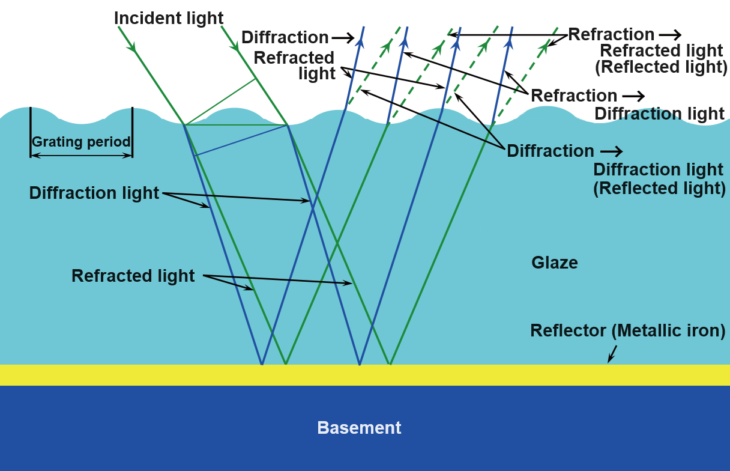
Figure 3: Oil spots where luster is observed are assumed to be a wrinkle structure
The wavelength and position of the diffracted light were estimated based on the assumption that there are periodic wrinkles on the sine curve-shaped surface of the glaze and a reflective layer of metallic iron on the back surface.
First, the saturation of the images taken by Nishikawa was increased to make the reflected light from the planar light source and the color of the luster more visible. The shape of the tea bowl was obtained from multiple Nishikawa images. In the case of light with wavelength of 400 nanometers (nm, 100 nm is 1/10,000 mm) was shone on it with a fixed position for the bowl, camera and planar light source, the reflected light from the planar light source and the position of the blue-green luster on the inside of the tea bowl indicated that the period of the wrinkles was estimated to be 900 nm. Calculations under these conditions showed that the blue-green luster could be explained without contradiction even if it was assumed that the glaze was 50-100 nm thick and that the light was diffracted by a two-dimensional wrinkle structure.
Conversely, “these calculations allow us to determine that the Yuteki tenmoku tea bowl should have brilliant diffraction when illuminated by a point source with a spherical spread,” says Ebizuka. This finding may provide clues for lighting that will bring out the best in the tea bowl when it is displayed or photographed in a museum.
Attempts to recreate tenmoku tea bowls with their beautiful oil spots and luster have been made in Japan since the 14th century. Even today, Nagae and many other potters continue to meet this challenge at a high level. “If we can find the conditions for the formation of a thin polycrystalline layer on the surface of the glaze and the cooling speed that creates wrinkles, we may be able to reproduce the luster of the Yuteki Tenmoku tea bowl, a national treasure,” says Ebizuka. The results of this research may provide clues to reviving the mysterious luster that was born in the Jian Kiln in China nearly 1,000 years ago.
The current investigation was based on high-resolution images of the tenmoku tea bowl and electron microscope photographs of the fragments, but Ebizuka says, “If we have the opportunity to measure the actual objects, including yohen tenmoku tea bowls, we may be able to uncover even more new facts using the latest technology.” Ebizuka is not the only one who is excited about this possibility.
Related article links
Press release dated October 11, 2023: “Exploring the secrets of the luster of the national treasure Yuteki Tenmoku tea bowl” (in Japanese)
JST: Science Japan – November 29, 2023: “RIKEN discovers the secret behind the color and luster of the ‘Yuteki Tenmoku’ Tea Bowl, a national treasure”
https://sj.jst.go.jp/news/202311/n1129-02k.html
This article was translated and reprinted with permission from the RIKEN institute, from Hikari no Senmonka, Tenmoku jawan ni Idomu (Optics Expert Takes on Tenmoku Tea Bowl), which was published in “Kenkyu Saizensen” (Research Frontiers) (February 9, 2024) in RIKEN Kurozuappu Kagaku-do 2024 (Close-up Science Kagaku-do [the way of science] 2024).
https://www.riken.jp/pr/closeup/2024/20240209_1/index.html (in Japanese)
Reportage and composition: Furugori Etsuko / Photography: Furusue Takuya / Production cooperation: SciTech Communications
[1] Tenmoku tea bowls are the Japanese name for black glazed tea bowls produced and used around the temples in Tianmu Mountain (Tenmoku-san in Japanese) in Zhejiang Province, China. It is said that during the Kamakura period (1185–1333), Japanese monks who studied abroad brought them back with them, and they became known as Tenmoku tea bowls.
[2] The name yuteki describes the gold, silver and blue iridescent spots resembling the oil drops floating on the surface of the water. [https://apisites.jmapps.ne.jp/mocoor_o/en/collection/25]
[3] https://www.miho.jp/booth/html/artcon/00010618e.htm
[4] Original paper information: Nagae / Fukushima, Toyo Toji, 41 (2011) 35-45
Keywords
- Ebizuka Noboru
- Ultrahigh Precision Optics Technology Team
- RIKEN Center for Advanced Photonics
- tenmoku
- tea bowls
- Yuteki Tenmoku
- Yohen Tenmoku
- Nogime Tenmoku
- national treasure
- ceramics
- glaze
- metallic iron
- thin-film interference
- luster
- iridescence
- oil spots
- wrinkles
- wavelength
- diffraction grating
- Song Dynasty
- Jian kiln
- grism
- optical engineering
- Nishikawa Shigeru
- Nagae Sokichi
- Fukushima Nobuaki


